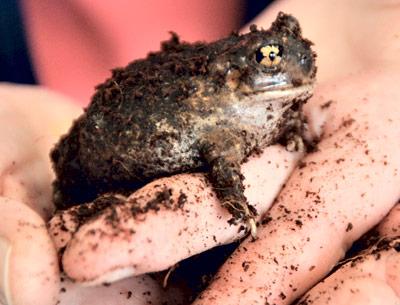The Other Songs of Spring: Alewives and Amphibians

As I write away midway through Sunday evening the outside temperature in Noyac has slowly crept down. It just fell a 10th of a degree below 35 degrees. I’m hoping that it never makes it to freezing. All the snow is gone and most of the fresh ponds have shed their icy coats. Should the weather hold for another three or four days and we get a touch of precipitation it might be just enough to start the great migration, not of birds — that’s already well in progress — but of amphibians and alewives.
Snowdrops were in full bloom behind the Sag Harbor Historical Society’s Annie Cooper Boyd House on Sunday, an age-old sign of winter’s passing. The alewives are massed in the Peconic Estuary’s many bays. It’s full moon time. Everything is in order for the great procession up the spawning streams to begin. The alewife run into Big Fresh Pond in North Sea from North Sea Harbor has been happening each March, hardly skipping a beat since colonial times. The stage is set for another magnificent return. Grangibel Park in Riverhead is the gateway to the Peconic River and its offshoot ponds. Alewives have been availing themselves of the fish passageway through to the river for just about every year since it was installed earlier in the millennium. Ligonee Brook handling Long Pond’s overflow needs an inch or so of rain to raise its elevation enough to start this longstanding stream flowing down towards Sag Harbor Cove. The streambed has been cleaned out and is ready and able.
Very few people are around to see the alewives when they move upstream. But just about everybody hears the spring peepers, Hyla crucifer, when they start chanting from their breeding ponds just before dark. A few people don’t like the racket, which can be almost deafening at its peak, but most, I’m told, look forward to the clarion call announcing the final end to winter. When those thousands of little gray tree frogs move into the vernal ponds and rev up their chorus, the annual migration of another amphibian, this one black with yellow spots is no doubt already under way. The peepers hop to the water, the spotted salamanders crawl to it in that typical one-leg-at-a-time gait, bending their body sinuously with each tiny advance.
The spotted salamanders are the most common of our four local species of mole salamanders in the genus Ambystoma. The eastern tiger salamander is the rarest and though it used to be in East Hampton, one hasn’t been found here in more than 50 years. The second least common one in the group is the blue-spotted salamander found on Long Island only in Montauk, although in the long-ago past it could also be found in Sag Harbor. While the peepers are chorusing, the male spotted salamanders are engaged in depositing little white sacs of sperm called spermatophores on submerged sticks and grasses for the females to hover over and uck them up into their cloacas where fertilization takes place after which the mass of sperm and eggs is re-deposited on a stick or reed to enable development to take place underwater.
The blue-spotted salamander emerges from the ground and goes to its breeding pond in the beginning of April during the same period when the Southern leopard frog would begin spawning in fresh offshoots of Oyster Pond in Montauk. The salamander is holding its own, as almost all of its breeding ponds are in preserved parkland. The Southern leopard frog is another story; it hasn’t been seen in Montauk or elsewhere on Long Island for more than 20 years.
The fourth mole salamander, the marbled salamander, dark gray flecked with silver, doesn’t breed until September. However, another of Long Island’s salamanders, the four-toed salamander, has a spotty distribution and is found here and there, including in Montauk and on Shelter Island. It likes sphagnum moss, so look for it during its April breeding season in sphagnous pockets of water.
The other local salamander, the leadback morph of the redback salamander, does not breed in water, but lays it eggs under rotting logs and such in woodland habitats. In this millennium it has been undergoing a major population turndown locally. Why? No one knows. I suspect wild turkeys are doing it in.
Back to the frogs. A second but more solitary noisemaker frog is the wood frog, Rana sylvatica. Its call is not unlike that of a crow with a low raspy voice. It likes woodlands and come April breeds in small ponds, many of which are ephemeral. The green and pickerel frogs sing and mate later in the spring. The bullfrog, not a native Long Islander, but imported from the South, starts its low jug-a-rum calls in late April to early May.
After the first big May or June rain, the gray treefrog starts trilling for its mates and if the rain is really big, the spadefoot toad, not a toad at all but more of a frog, digs itself out of the earth and begins its nonstop “crowing” in temporary ponds, especially those found in slacks between adjacent dunes along the oceanfront of Amagansett.
The only true toad on Long Island is Bufo fowlerii, or the Fowler’s toad. It comes in two color phases: a darkish morph found in woodlands and a light gray morph occupying open areas such as golf courses but especially dunes where it feeds on dune grasshoppers, dune spiders, and other dune insects. After wet weather in May it is heard uttering its long low monotonic bleats from golf course ponds and those vernal ones situated in the same dunes where spadefoots breed. Its warts secrete an acrid fluid, which makes it unpalatable to frog predators, but the eastern hognose snake, also a creature of the dunes, somehow doesn’t seem to mind. It feeds almost exclusively on Fowler’s toads.
Long Island once had cricket frogs, the smallest of the frogs in the Northeast. Their call is like the sound produced by one of those toy clickers. The New York State Department of Environmental Conservation is presently contemplating repopulating them here.


